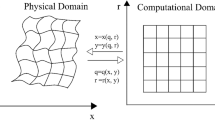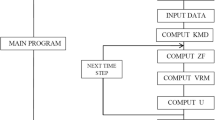Abstract
A hybrid method combining finite element and 4th-order finite difference techniques is developed to model SH and P-SV seismic wave propagation in a 2D elastic medium with irregular surface topography. Both the classic staggered grid finite difference scheme and the partially staggered grid scheme are tested. The accuracy of the hybrid method is studied by comparison with a semi-analytical and another numerical method. Subsequently, to study the amplification, numerical simulations of seismic wave propagation in a series of hills are carried out and compared with the single-hill case. Depending on the position of the source in relation to the topography, the ratio between the heights and lengths of the hills or the ratio between the lengths of the hills and the wavelength, the presence of several hills as opposed to a single one can increase the amplification effect due to topography. This study highlights the fact that, when evaluating topographic site effects, surrounding topography must be taken into account in addition to local topography.
Similar content being viewed by others
References
Aoi S, Fujiwara H (1999) 3D finite-difference method using discontinuous grids. Bull Seism Soc Am 89: 918–930
Badea L, Ionescu IR, Wolf S (2008) Schwarz method for earthquake source dynamics. J Comput Phys 227: 3824–3848
Bielak J, Loukakis K, Hisada Y, Yoshimura C (2003) Domain reduction method for three-dimensional earthquake modelling in localized regions. Part I Theory Bull Seism Soc Am 93: 817–824
De Martin F (2011) Verification of a spectral-element method code for the southern California earthquake center LOH.3 viscoelastic Case. Bull Seism Soc Am 101: 2855–2865
De Martin F, Modaressi H, Aochi H (2007) Coupling of FDM and FEM in seismic wave propagation. In: 4th international conference on earthquake geotechnical engineering, Thessaloniki, Greece, 25–28 June 2007
Fäh D (1992) A hybrid technique for the estimation of strong ground motion in sedimentary basins. Dissertation, Swiss Federal Institute of Technology
Gaffet S, Bouchon M (1989) Effects of two-dimensional topographies using the discrete wavenumber—boundary integral equation method in P-SV cases. J Acoust Soc Am 85: 2277–2283
Gatmiri B, Arson C, Nguyen KV (2008) Seismic site effects by an optimized 2D BE/FE method I. Theory, numerical optimization and application to topographical irregularities. Soil Dyn Earthq Eng 28: 632–645
Graves RW (1996) Simulating seismic wave propagation in 3D elastic media using staggered-grid finite differences. Bull Seism Soc Am 86: 1091–1106
Griffiths DW, Bollinger GA (1979) The effect of Appalachian Mountain topography on seismic waves. Bull Seism Soc Am 69: 1081–1105
Hartzell SH, Carver DL, King KW (1994) Initial investigation of site and topographic effects at Robinwood Ridge, California. Bull Seism Soc Am 84: 1336–1349
Kawase H (1988) Time-domain response of a semi-circular canyon for incident SV, P, and Rayleigh waves calculated by the discrete wavenumber boundary element method. Bull Seism Soc Am 78: 1415–1437
Komatitsch D, Martin R (2007) An unsplit convolutional Perfectly Matched Layer improved at grazing incidence for the seismic wave equation. Geophysics 72: SM155–167
Komatitsch D, Vilotte J-P (1998) The spectral element method: an efficient tool to simulate the seismic response of 2D and 3D geological structures. Bull Seism Soc Am 88: 368–392
Levander AR (1988) Fourth-order finite-difference P-SV seismograms. Geophysics 53: 1425–1436
Ma S, Archuleta RJ, Liu P (2004) Hybrid modeling of elastic P-SV wave motion: a combined finite-element and staggered-grid finite-difference approach. Bull Seism Soc Am 94: 1557–1563
Madariaga R (1976) Dynamics of an expanding circular fault. Bull Seism Soc Am 65: 163–182
Moczo P, Bystrický E, Kristek J, Carcione JM, Bouchon M (1997) Hybrid modeling of P-SV seismic motion at inhomogeneous viscoelastic topographic structures. Bull Seism Soc Am 87: 1305–1323
Moczo P, Kristek J, Halada L (2000) 3D fourth-order staggered-grid finite-difference schemes: stability and grid dispersion. Bull Seism Soc Am 90: 587–603
Ohminato T, Chouet BA (1997) A free-surface boundary condition for including 3D topography in the finite-difference method. Bull Seism Soc Am 87: 494–515
Saenger EH, Gold N, Shapiro SA (2000) Modeling the propagation of elastic waves using a modified finite-difference grid. Wave Motion 31: 77–92
Spudich PA, Hellweg M, Lee WHK (1996) Directional topographic site response at Tarzana observed in aftershocks of the 1994 Northridge, California, earthquake: implications for mainshock motions. Bull Seism Soc Am 86: S193–S208
Trifunac MD (1971) Surface motion of a semi-cylindrical alluvial valley for incident plane SH waves. Bull Seism Soc Am 61: 1755–1770
Trifunac MD (1973) Scattering of plane SH waves by a semi-cylindrical canyon. Earthq Eng Struct Dyn 1: 267–281
Virieux J (1986) P-SV wave propagation in heterogeneous media: velocity-stress finite-difference method. Geophysics 51: 889–901
Wolf S, Favreau P, Ionescu IR (2006) Finite element—finite difference coupling for elastodynamic rupture propagation. In: AGU fall meeting, San Francisco, USA, 11–15 December 2006
Wong HL (1979) Diffraction of P, SV, and Rayleigh waves by surface topographies. Report CE79-05, Department of Civil Engineering, University of Southern California, Los Angeles, California
Wong HL (1982) Effect of surface topography on the diffraction of P, SV, and Rayleigh waves. Bull Seism Soc Am 72: 1167–1183
Zahradník J, Moczo P (1996) Hybrid seismic modeling based on discrete-wavenumber and finite-difference methods. Pure Appl Geophys 148: 21–38
Author information
Authors and Affiliations
Corresponding author
Rights and permissions
About this article
Cite this article
Ducellier, A., Aochi, H. Interactions between topographic irregularities and seismic ground motion investigated using a hybrid FD-FE method. Bull Earthquake Eng 10, 773–792 (2012). https://doi.org/10.1007/s10518-011-9335-6
Received:
Accepted:
Published:
Issue Date:
DOI: https://doi.org/10.1007/s10518-011-9335-6




